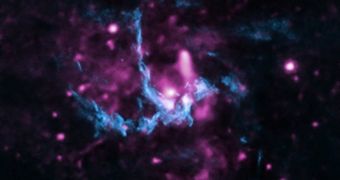For a very long time, astrophysicists have argued that the supermassive black hole at the center of the Milky Way should produce jets of high-energy particles. These formations were thought to extend above and below the galactic plane, but studies failed to identify them with any degree of precision until now.
Researchers at the University of California in Los Angeles (UCLA), the Nanjing University, in China, and the Massachusetts Institute of Technology (MIT) used data collected by the NASA Chandra X-ray Observatory (CXO) to investigate our galaxy's central black hole, called Sagittarius A* (SgrA*).
Additional radio wavelength data were collected by the Karl G. Jansky Very Large Array (VLA) telescope, which is operated by the National Radio Astronomy Observatory (NRAO) for the US National Science Foundation (NSF).
This work is the first to provide conclusive evidence of the high-energy particle jets emanating from Sagittarius A*. Previously, researches conducted on this issue have yielded contradictory results, so their conclusions were not considered to be definitive.
Details of the work were published in the latest online issue of the esteemed Astrophysical Journal, and will be made available in a future print issue of the journal. The lead author of the study was Nanjing University investigator Zhiyuan Li.
“For decades astronomers have looked for a jet associated with the Milky Way's black hole. Our new observations make the strongest case yet for such a jet,” the astronomer says. Li adds that these jets play an important role in controlling the formation of new stars in the Milky Way.
Particle jets are produced by black holes of all sizes, as well as by young stars that have not yet reached their main sequence. These formations are primarily responsible for transporting heat and energy away from the objects that produce them, thus contributing to promoting the mixture of chemicals in the Cosmos.
“We were very eager to find a jet from Sgr A* because it tells us the direction of the black hole's spin axis. This gives us important clues about the growth history of the black hole,” says UCLA expert Mark Morris, who was also a co-author of the new study.
Using Chandra and VLA observations, the team determined that the spin axis of the black hole is parallel to the rotation axis of our galaxy. This suggests that Sagittarius A* did not merge with any other large black holes recently, and that the Milky Way did not collide with other massive galaxies.

 14 DAY TRIAL //
14 DAY TRIAL //